White Rim Road
excerpted from our book
Canyonlands National Park
Favorite Jeep Roads & Hiking Trails
pages 23-39
|
Buy book directly from the author!
Canyonlands National Park
Favorite Jeep Roads & Hiking Trails
- has access info for 75 trailheads
- 56 detailed trail maps
- 241 photographs
- loads of driving and hiking tips
|
regularly $14.95
now on sale for only
$11.95
click here
for book orders
|
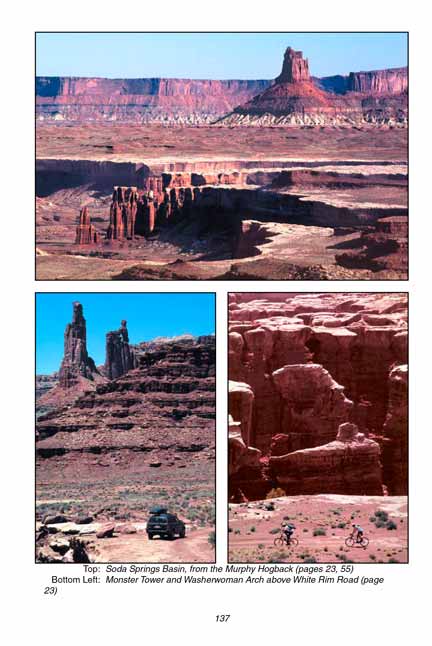
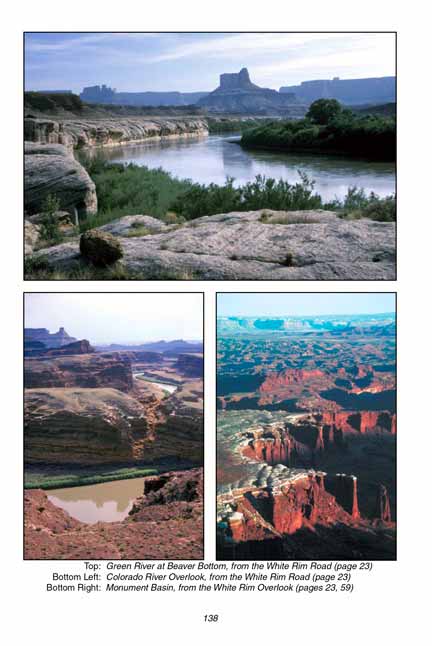
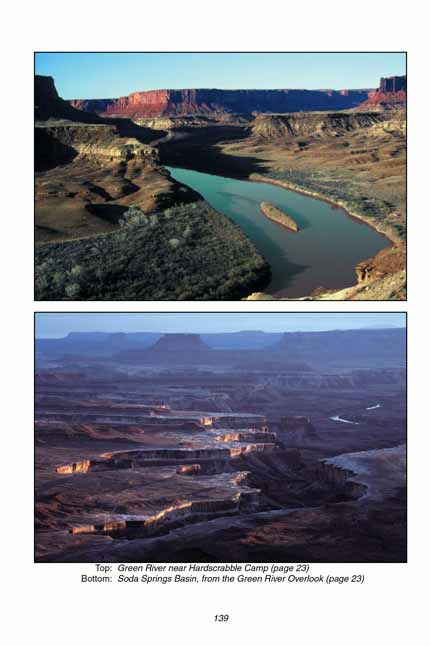
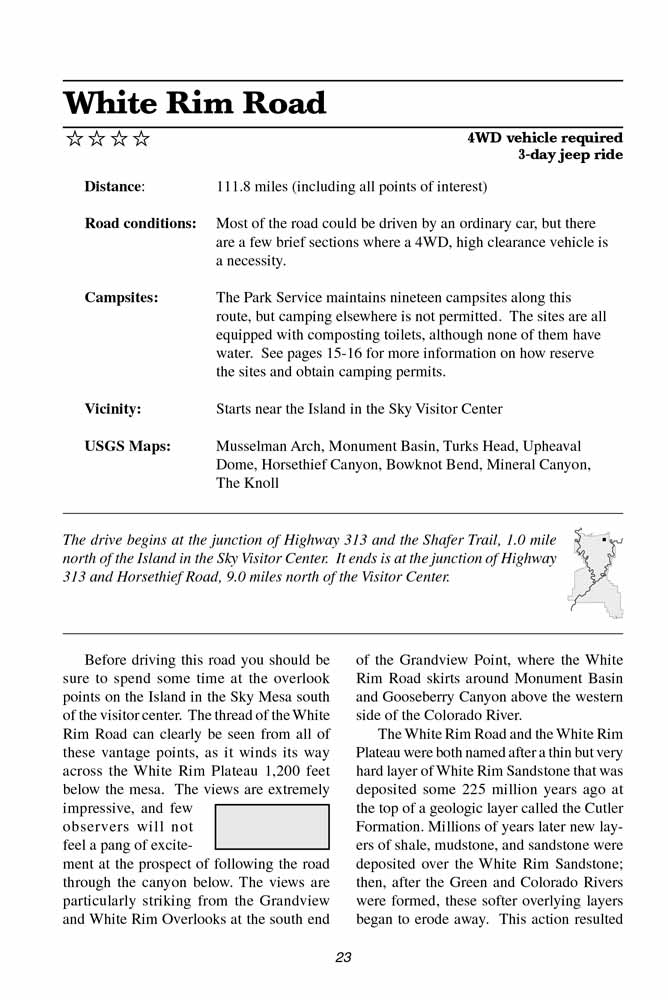 Before driving the White Rim Road you should be sure to spend some time at the overlook points on the Island in the Sky Mesa south of the
visitor center. The thread of the White Rim Road can clearly be seen from all of these vantage points, as it winds its way across the White Rim Plateau
1,200 feet below the mesa. The views are extremely impressive, and few observers will not feel a pang of excitement at the prospect of following the
road through the canyon below. The views are particularly striking from the Grandview and White Rim Overlooks at the south end of the Grandview Point,
where the White Rim Road skirts around Monument Basin and Gooseberry Canyon above the western side of the Colorado River.
Before driving the White Rim Road you should be sure to spend some time at the overlook points on the Island in the Sky Mesa south of the
visitor center. The thread of the White Rim Road can clearly be seen from all of these vantage points, as it winds its way across the White Rim Plateau
1,200 feet below the mesa. The views are extremely impressive, and few observers will not feel a pang of excitement at the prospect of following the
road through the canyon below. The views are particularly striking from the Grandview and White Rim Overlooks at the south end of the Grandview Point,
where the White Rim Road skirts around Monument Basin and Gooseberry Canyon above the western side of the Colorado River.
The White Rim Road and the White Rim Plateau were both named after a thin but very hard layer of White Rim Sandstone that was deposited some 225 million
years ago at the top of a geologic layer called the Cutler Formation. Millions of years later new layers of shale, mudstone, and sandstone were deposited
over the White Rim Sandstone; then, after the Green and Colorado Rivers were formed, these softer overlying layers began to erode away. This action
resulted in the formation of a wide, flat bench of desert, the White Rim Plateau, that now lies between the river gorges below and the mesa tops above.
In the early 1950s uranium was discovered in the shales overlying the White Rim Sandstone, and the flat bench became a natural access route for building
roads to the mining claims. Thus the White Rim Road was born. The uranium boom lasted for only 3-4 years, however, and the primitive road was never
improved. After the mid-1950s new discoveries in more accessible places caused the price of the yellow ore to plunge, and by the end of the decade the
mines in Canyonlands were abandoned.
When Canyonlands National Park was formed in 1964 there was some talk of improving the White Rim Road into a scenic loop drive, but fortunately that
never happened. Today, thanks to the short-lived uranium boom and the wise foresight of early park mangers, the White Rim Road has become one of the
premier recreational jeep and mountain biking roads in the United States. The Park Service has built nineteen primitive campsites along its 70-mile
length (for which reservations are required), but no further development is contemplated.
Airport Camp (17.3 miles)
From Highway 313 the road proceeds south for 0.8 mile to the edge of Shafer Canyon. It then turns west onto a narrow bench just below the Navajo Sandstone,
which it follows for the next 1.9 miles before beginning a series of dramatic switchbacks that lead down into the bottom of the gorge. This section of
road, known as the Shafer Trail, was first developed as a horse trail around 1917 by a cattle rancher named Sog Shafer. Then in 1952 a group of local
miners and other businessmen improved the road so it could be used to haul uranium ore from mines near Potash and the Colorado River to the top of the
mesa.
After five large switchbacks the Shafer Trail straightens out and continues its descent down through the bottom of Shafer Canyon, finally arriving at the
junction with the Potash Road 5.2 miles from the Highway. This junction marks the beginning of the White Rim Road, and you should bear to the right here.
Continue east towards the Colorado River for another 1.3 miles until you see a small sign on the left marking the Gooseneck Trailhead.
The Gooseneck Trail offers the first opportunity along the
White Rim Road to get a good look at the Colorado River. It also serves as an introduction to the
White Rim Sandstone, which first becomes visible in this area. The panorama of the Colorado River below the trail is very picturesque, but if you
want to take pictures you should have a wide-angle lens. (See page 89 for a complete description of this trail.)
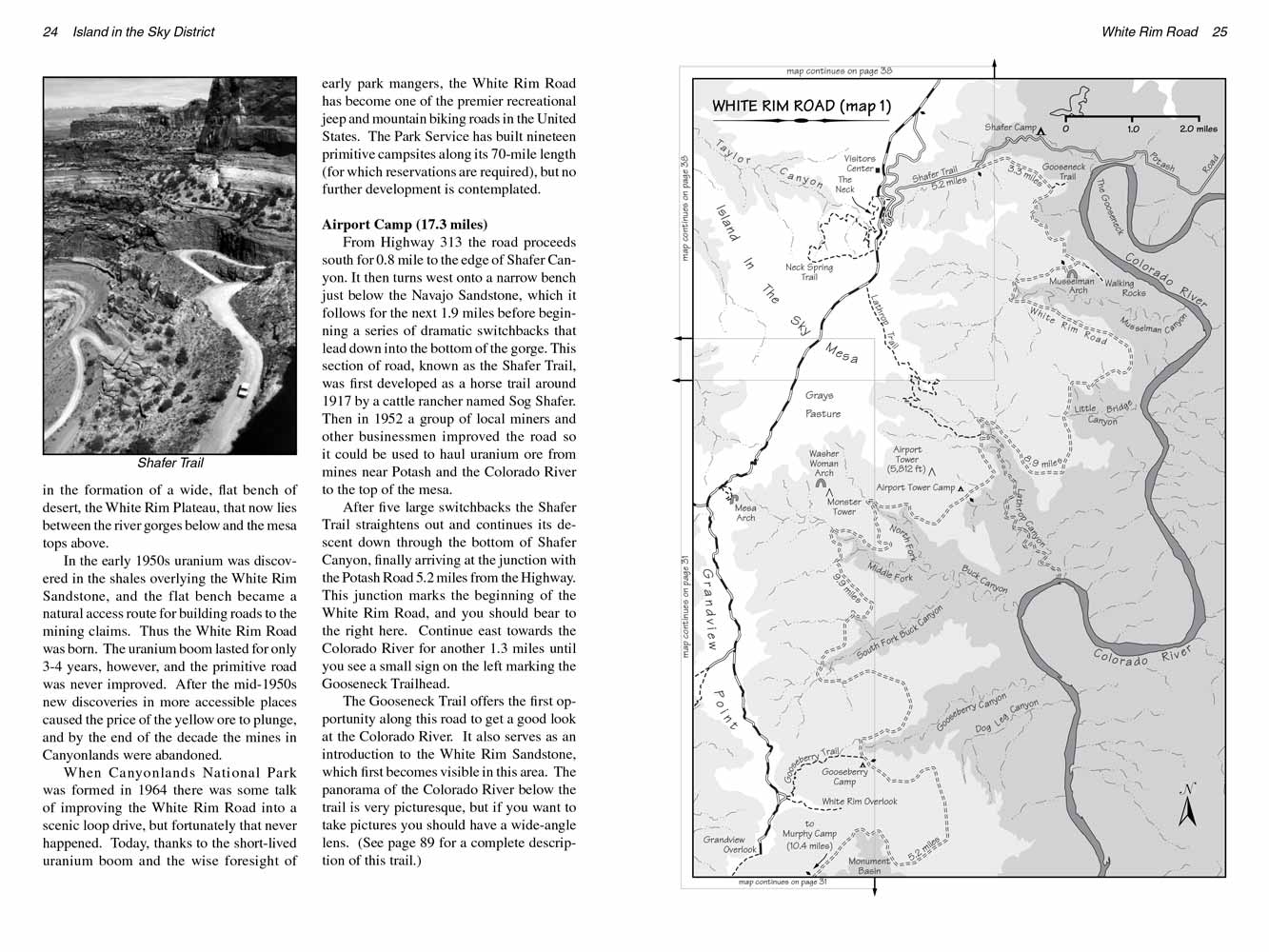 The White Rim Road continues along the top of the White Rim Formation as it proceeds south from the Gooseneck Trailhead. Initially the
sandstone layer is less than ten feet thick, but it gradually becomes much thicker. After another 1.8 miles you will come to another sign that says
“Colorado River Overlook”, and from there a short spur road leads to another overlook point just 300 yards from the main road. This view of the river
is not as spectacular as the one from the end of the Gooseneck Trail, but no hiking is required to reach the Colorado River Overlook.
The White Rim Road continues along the top of the White Rim Formation as it proceeds south from the Gooseneck Trailhead. Initially the
sandstone layer is less than ten feet thick, but it gradually becomes much thicker. After another 1.8 miles you will come to another sign that says
“Colorado River Overlook”, and from there a short spur road leads to another overlook point just 300 yards from the main road. This view of the river
is not as spectacular as the one from the end of the Gooseneck Trail, but no hiking is required to reach the Colorado River Overlook.
Although the Colorado River Overlook is not particularly impressive, there is an extremely interesting area a short distance east of the overlook point
called the Walking Rocks. Walk along the rim from the car park for about 0.2 mile and you will begin to see a number of long narrow cracks near the
edge of the White Rim Sandstone. These cracks occur where large blocks of the 20-foot-thick layer of sandstone have broken away from the main formation
but are still supported by the underlying Organ Shale and have not yet fallen into the canyon below. Many of the cracks are only 6-18 inches wide;
consequently it is possible to jump from one balanced rock to the next, like following a series of giant mushroom-shaped stepping stones that lead
to nowhere. Crossing the narrow gaps between the blocks is not particularly dangerous, but gazing down at a hundred feet of empty space under your
feet as you hop from rock to rock is very unnerving. It is not a good place for careless people, and I would definitely not recommend it for
children. It is also not a place you would want to be during an earthquake. Indiana Jones would love the Walking Rocks
The next point of interest along the White
Rim Road, the Musselman Arch, is only 0.2 mile beyond the Colorado River Overlook. The arch is located 150 yards from the
White Rim Road
at the end of another turnout on the left. Again, the arch was formed when a piece of the White Rim cracked away from the plateau, but this time the
shale washed away from underneath its center forming a natural arch about 80 feet long. There is no easy way to get below the White Rim at Musselman
Arch, but if you want to climb under the arch you can get there from the Walking Rocks. From there it is possible to climb to the bottom of the
White Rim Formation and scramble back 0.5 mile to a point below Musselman Arch.
The old timers in Moab tell an interesting story about how Musselman Arch got its name. Sometime in the early 1940s a man named Ross Musselman heard
about the arch and persuaded a friend in Moab to show him where it was. He owned a dude ranch in the area and was looking for interesting places to
take his guests. Word of the arch spread quickly after Musselman began showing it, and before long outsiders visiting the area started calling it
the Musselman Arch. Needless to say this greatly irritated the local cowboys and ranchers who had known about the arch for decades before it was
“discovered” by Ross Musselman. They grumbled for years about his ill-deserved fame. Now, as if to rub salt into the old timers’ wounds, the USGS
has also given Musselman’s name to a nearby canyon and even to the 7.5 minute topographical map covering this section of Canyonlands.
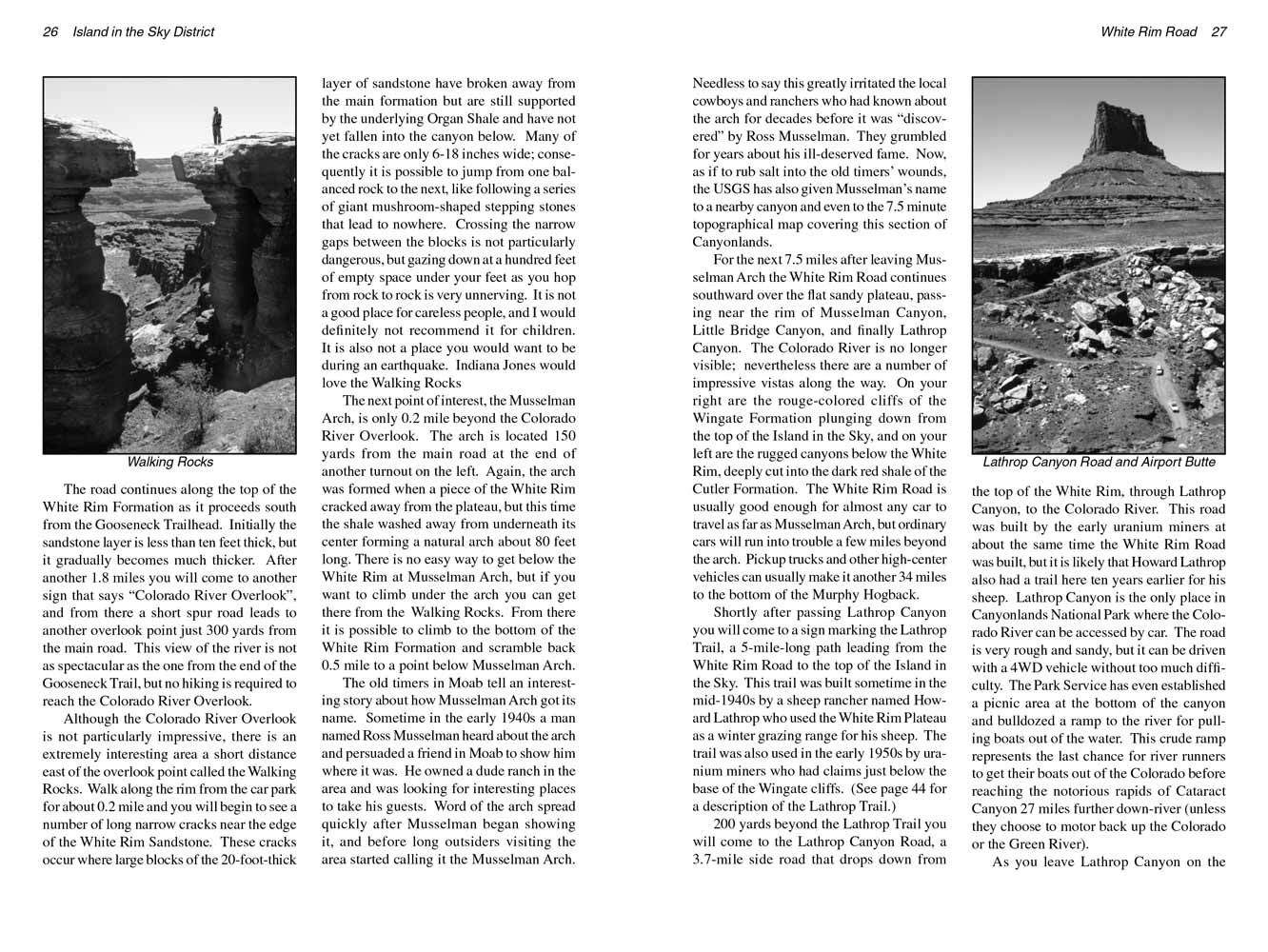 For the next 7.5 miles after leaving Musselman Arch the White Rim Road continues southward over the flat sandy plateau, passing near
the rim of Musselman Canyon, Little Bridge Canyon, and finally Lathrop Canyon. The Colorado River is no longer visible; nevertheless there are a number
of impressive vistas along the way. On your right are the rouge-colored cliffs of the Wingate Formation plunging down from the top of the Island in
the Sky, and on your left are the rugged canyons below the White Rim, deeply cut into the dark red shale of the Cutler Formation. The White Rim Road
is usually good enough for almost any car to travel as far as Musselman Arch, but ordinary cars will run into trouble a few miles beyond the arch.
Pickup trucks and other high-center vehicles can usually make it another 34 miles to the bottom of the Murphy Hogback.
For the next 7.5 miles after leaving Musselman Arch the White Rim Road continues southward over the flat sandy plateau, passing near
the rim of Musselman Canyon, Little Bridge Canyon, and finally Lathrop Canyon. The Colorado River is no longer visible; nevertheless there are a number
of impressive vistas along the way. On your right are the rouge-colored cliffs of the Wingate Formation plunging down from the top of the Island in
the Sky, and on your left are the rugged canyons below the White Rim, deeply cut into the dark red shale of the Cutler Formation. The White Rim Road
is usually good enough for almost any car to travel as far as Musselman Arch, but ordinary cars will run into trouble a few miles beyond the arch.
Pickup trucks and other high-center vehicles can usually make it another 34 miles to the bottom of the Murphy Hogback.
Shortly after passing Lathrop Canyon you will come to a sign marking the Lathrop Trail, a 5-mile-long path leading from the White Rim Road to the top
of the Island in the Sky. This trail was built sometime in the mid-1940s by a sheep rancher named Howard Lathrop who used the White Rim Plateau as a
winter grazing range for his sheep. The trail was also used in the early 1950s by uranium miners who had claims just below the base of the Wingate
cliffs. (See page 44 for a description of the Lathrop Trail.)
200 yards beyond the Lathrop Trail you will come to the Lathrop Canyon Road, a 3.7-mile side road that drops down from the top of the White Rim, through
Lathrop Canyon, to the Colorado River. This road was built by the early uranium miners at about the same time the White Rim Road was built, but it is
likely that Howard Lathrop also had a trail here ten years earlier for his sheep. Lathrop Canyon is the only place in Canyonlands National Park where
the Colorado River can be accessed by car. The road is very rough and sandy, but it can be driven with a 4WD vehicle without too much difficulty.
The Park Service has even established a picnic area at the bottom of the canyon and bulldozed a ramp to the river for pulling boats out of the water.
This crude ramp represents the last chance for river runners to get their boats out of the Colorado before reaching the notorious rapids of
Cataract Canyon 27 miles further down-river (unless they choose to motor back up the Colorado or the Green River).
As you leave Lathrop Canyon on the White Rim Road you will see the Airport Tower Butte on the right side, and after 0.9 mile you will arrive at Airport
Tower Campsites A and B, the first of the nineteen campsites along the White Rim Road. Sites C and D are 0.4 miles further.
 Gooseberry Camp (10.6 miles)
Gooseberry Camp (10.6 miles)
Soon after leaving the Airport Tower Campsites C and D, another distinctive pinnacle of sandstone called the Monster Tower will come into view on the
right side of the White Rim Road. You can also see the Washerwoman Arch high on the sandstone cliffs of a smaller pinnacle on the north side of the Monster Tower.
Look carefully at the smaller tower, and if you have a good imagination you should be able to identify the giant stone woman washing her clothes.
About a half-mile east of these landmarks the
White Rim Road crosses Buck Canyon, a heavily eroded canyon that was used by sheep rancher Howard Lathrop in the 1940s.
Lathrop used the canyon to pen up his rams after the spring breeding season while the ewes were nursing their newborn lambs. Off-trail hikers might want
to take note: It is a relatively easy walk of 5.2 miles from the road down Buck Canyon to the Colorado River. There are also several seasonal springs
in the canyon.
From Buck Canyon the White Rim Road continues to work its way southward along the base of Grandview Point, meandering around the heads of the Middle and South Forks
of Buck Canyon, and then Gooseberry Canyon 8.5 miles later. The road passes very close to the rims of these canyons, but nowhere as close as at head of
South Fork Buck Canyon. Be careful here, because at one point your left tires will be only three feet away from a 200-foot drop. Furthermore the White
Rim is undercut by about 40 feet, leaving nothing but air under the road!
3.1 miles beyond South Fork Buck Canyon the
White Rim Road crosses the wash above Gooseberry Canyon, where you will see another sign marking the Gooseberry
Trailhead. The Gooseberry Trail was built in the late 1930s by WPA workers, and many old timers in the area still call it the Government Trail.
Like several other trails in the area, it was built to enable local sheep and cattle ranchers to take their livestock from the Island in the Sky
Mesa to the White Rim Plateau for winter grazing. (See page 56 for a description of this trail.) Gooseberry Campsites A and B are located 0.3 and
0.4 miles past the trailhead.
White Crack Camp (9.5 miles)
4.1 miles after leaving Gooseberry Campsite B you will come to one of the most impressive sights on the White Rim Road: Monument Basin. This area is well
known because so many people have seen it from above. It lies just below the heavily visited Grandview Overlook on the southern end of the Island in the
Sky, and every day hundreds of tourists peer down at Monument Basin’s fascinating collection of geologic sculpture 1,900 feet below the mesa top. The
basin consists of a large rocky desert valley about a mile across and 500 feet below the White Rim Plateau that is filled with dozens of pillars of
Organ Shale capped with blocks of White Rim Sandstone. The White Rim Road first approaches the basin on its northeast side and then follows its perimeter for
the next three miles, giving onlookers the opportunity to view the spectacle from many different angles. The vista is particularly impressive in
the late afternoon when the shale turns a deep red color and the pinnacles cast long shadows across the canyon floor.
As you leave the last viewpoint on the west side of Monument Basin the
White Rim Road swings to the west and arrives shortly at a sign marking the spur to White
Crack Camp. This campsite is located 1.3 miles from the main road at the extreme southern end of the White Rim Plateau. White Crack Camp, with its
great views from the edge of the White Rim, is one of my favorites. Since it is located some distance from the main road it is quieter and more
private, and there is room for only one group of campers.
The White Crack Camp was named after a crack in the White Rim Sandstone just south of the car parking area. This break in the White Rim was developed
into a trail around 1918 so ranchers could get their animals to water in the lower canyons. Then in the early 1950s the trail was widened into a jeep
road and extended to a mining camp above the Green River. Today the jeep road is no longer suitable for wheeled vehicles, but it is possible to hike
along it to the old mining camp. The distance is 6.2 miles each way. There are no longer any standing buildings at the mining camp, but there are
a few artifacts lying about and the trail also offers some great views of the Green River. The White Crack Trail is discussed in greater detail on
page 92.
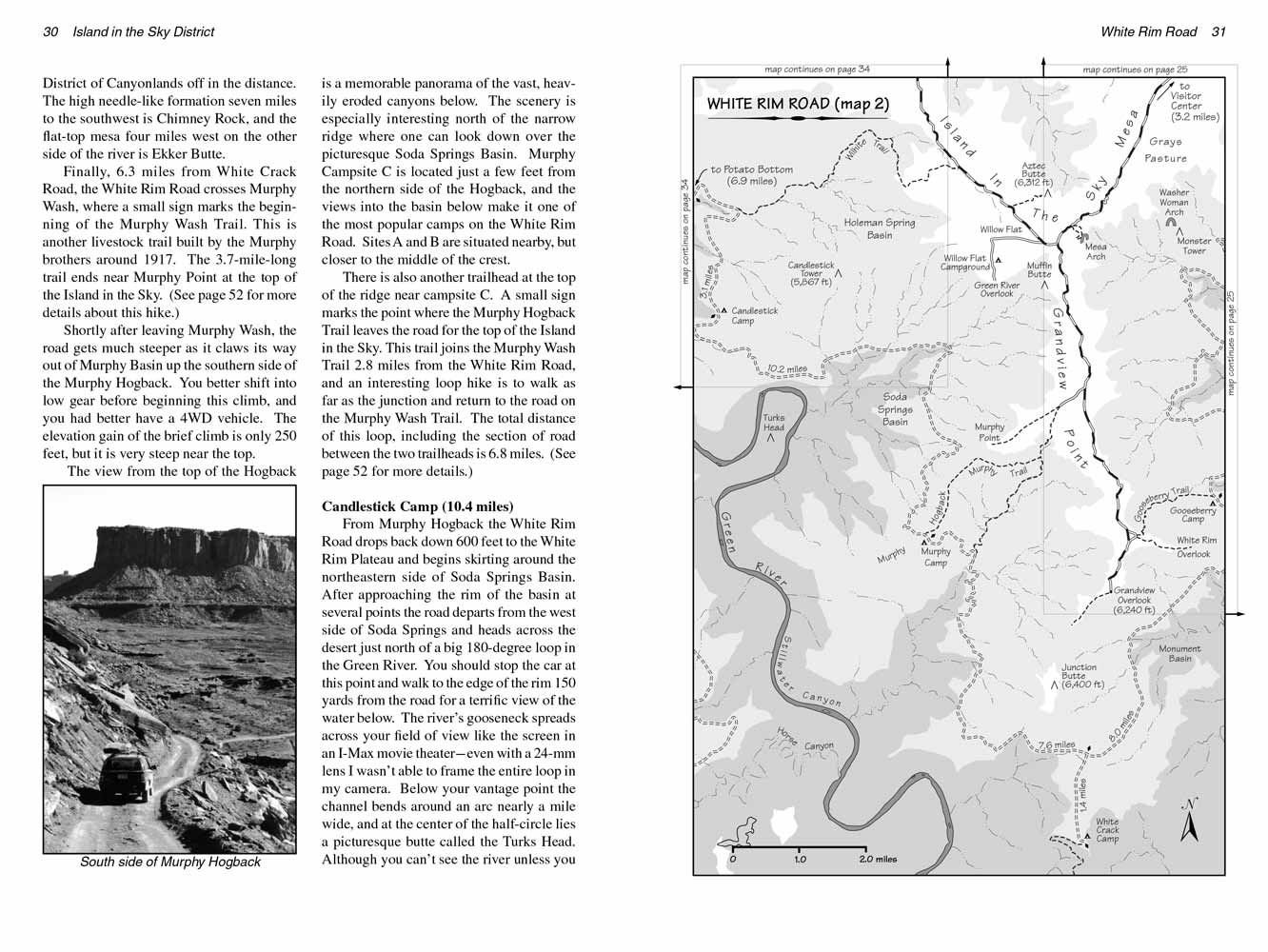 Murphy Camp (8.8 miles)
Murphy Camp (8.8 miles)
White Crack Camp lies at the extreme southern end of the Island in the Sky district. Upon leaving this area the
White Rim Road first goes west for about two miles
in order to get around Junction Butte, and then makes a sharp right turn as it begins the long journey up the west side of Grandview Point. Soon
the White Rim Road
enters a region known as Murphy Basin, named after a family that ran cattle here just after World War One. There are several nice views along this
section of road. If you look west across the Green River Gorge you can see many famous landmarks in the Maze District of Canyonlands off in the
distance. The high needle-like formation seven miles to the southwest is Chimney Rock, and the flat-top mesa four miles west on the other side of
the river is Ekker Butte.
Finally, 6.3 miles from White Crack Road, the White Rim Road crosses Murphy Wash, where a small sign marks the beginning of the Murphy Wash Trail. This
is another livestock trail built by the Murphy brothers around 1917. The 3.7-mile-long trail ends near Murphy Point at the top of the Island in the Sky.
(See page 52 for more details about this hike.)
Shortly after leaving Murphy Wash, the road gets much steeper as it claws its way out of Murphy Basin up the southern side of the Murphy Hogback. You
better shift into low gear before beginning this climb, and you had better have a 4WD vehicle. The elevation gain of the brief climb is only 250 feet,
but it is very steep near the top.
The view from the top of the Hogback is a memorable panorama of the vast, heavily eroded canyons below. The scenery is especially interesting north
of the narrow ridge where one can look down over the picturesque Soda Springs Basin. Murphy Campsite C is located just a few feet from the northern
side of the Hogback, and the views into the basin below make it one of the most popular camps on the White Rim Road. Sites A and B are situated nearby,
but closer to the middle of the crest.
There is also another trailhead at the top of the ridge near campsite C. A small sign marks the point where the Murphy Hogback Trail leaves the road for
the top of the Island in the Sky. This trail joins the Murphy Wash Trail 2.8 miles from the White Rim Road, and an interesting loop hike is to walk as far
as the junction and return to the road on the Murphy Wash Trail. The total distance of this loop, including the section of road between the two
trailheads is 6.8 miles. (See page 52 for more details.)
Candlestick Camp (10.4 miles)
From Murphy Hogback the White Rim Road drops back down 600 feet to the White Rim Plateau and begins skirting around the northeastern side of Soda Springs
Basin. After approaching the rim of the basin at several points the road departs from the west side of Soda Springs and heads across the desert just
north of a big 180-degree loop in the Green River. You should stop the car at this point and walk to the edge of the rim 150 yards from the road for
a terrific view of the water below. The river’s gooseneck spreads across your field of view like the screen in an I-Max movie theater-even with a
24-mm lens I wasn’t able to frame the entire loop in my camera. Below your vantage point the channel bends around an arc nearly a mile wide, and
at the center of the half-circle lies a picturesque butte called the Turks Head. Although you can’t see the river unless you get out of your car
and walk to the edge of the rim, the huge flat top of the Turks Head is clearly visible from the road, so when you see it be sure to stop.
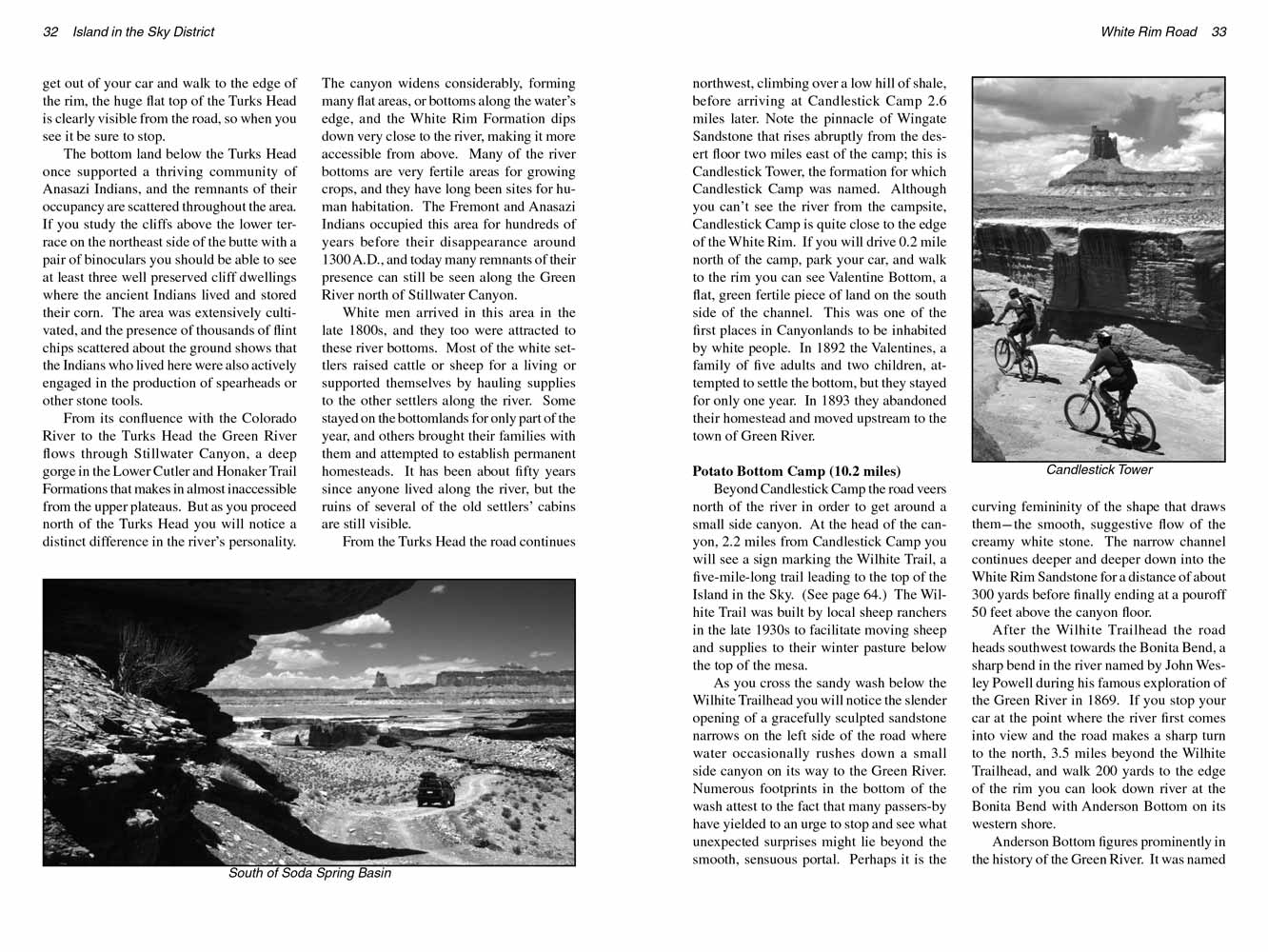 The bottom land below the Turks Head once supported a thriving community of Anasazi Indians, and the remnants of their occupancy are
scattered throughout the area. If you study the cliffs above the lower terrace on the northeast side of the butte with a pair of binoculars you should
be able to see at least three well preserved cliff dwellings where the ancient Indians lived and stored their corn. The area was extensively
cultivated, and the presence of thousands of flint chips scattered about the ground shows that the Indians who lived here were also actively engaged
in the production of spearheads or other stone tools.
The bottom land below the Turks Head once supported a thriving community of Anasazi Indians, and the remnants of their occupancy are
scattered throughout the area. If you study the cliffs above the lower terrace on the northeast side of the butte with a pair of binoculars you should
be able to see at least three well preserved cliff dwellings where the ancient Indians lived and stored their corn. The area was extensively
cultivated, and the presence of thousands of flint chips scattered about the ground shows that the Indians who lived here were also actively engaged
in the production of spearheads or other stone tools.
From its confluence with the Colorado River to the Turks Head the Green River flows through Stillwater Canyon, a deep gorge in the Lower Cutler and
Honaker Trail Formations that makes in almost inaccessible from the upper plateaus. But as you proceed north of the Turks Head you will notice a
distinct difference in the river’s personality. The canyon widens considerably, forming many flat areas, or bottoms along the water’s edge, and the
White Rim Formation dips down very close to the river, making it more accessible from above. Many of the river bottoms are very fertile areas for
growing crops, and they have long been sites for human habitation. The Fremont and Anasazi Indians occupied this area for hundreds of years before
their disappearance around 1300 A.D., and today many remnants of their presence can still be seen along the Green River north of Stillwater Canyon.
White men arrived in this area in the late 1800s, and they too were attracted to these river bottoms. Most of the white settlers raised cattle or
sheep for a living or supported themselves by hauling supplies to the other settlers along the river. Some stayed on the bottomlands for only part
of the year, and others brought their families with them and attempted to establish permanent homesteads. It has been about
seventy years since anyone
lived along the river, but the ruins of several of the old settlers’ cabins are still visible.
From the Turks Head the White Rim Road continues northwest, climbing over a low hill of shale, before arriving at Candlestick Camp 2.6 miles later. Note the
pinnacle of Wingate Sandstone that rises abruptly from the desert floor two miles east of the camp; this is Candlestick Tower, the formation for which
Candlestick Camp was named. Although you can’t see the river from the campsite, Candlestick Camp is quite close to the edge of the White Rim. If
you will drive 0.2 mile north of the camp, park your car, and walk to the rim you can see Valentine Bottom, a flat, green fertile piece of land on
the south side of the channel. This was one of the first places in Canyonlands to be inhabited by white people. In 1892 the Valentines, a family
of five adults and two children, attempted to settle the bottom, but they stayed for only one year. In 1893 they abandoned their homestead and
moved upstream to the town of Green River.
 Potato Bottom Camp (10.2 miles)
Potato Bottom Camp (10.2 miles)
Beyond Candlestick Camp the White Rim Road veers north of the river in order to get around a small side canyon. At the head of the canyon, 2.2 miles from
Candlestick Camp you will see a sign marking the Wilhite Trail, a five-mile-long trail leading to the top of the Island in the Sky. (See page 64.) The
Wilhite Trail was built by local sheep ranchers in the late 1930s to facilitate moving sheep and supplies to their winter pasture below the top of the
mesa.
As the White Rim Road crosses the sandy wash below the Wilhite Trailhead you will notice the slender opening of a gracefully sculpted sandstone narrows on the left side
of the road where water occasionally rushes down a small side canyon on its way to the Green River. Numerous footprints in the bottom of the wash attest
to the fact that many passers-by have yielded to an urge to stop and see what unexpected surprises might lie beyond the smooth, sensuous portal.
Perhaps it is the curving femininity of the shape that draws them into the smooth, suggestive flow of the creamy white stone. The narrow channel
continues deeper and deeper down into the White Rim Sandstone for a distance of about 300 yards before finally ending at a pouroff 50 feet above
the canyon floor.
After the Wilhite Trailhead the White Rim Road heads southwest towards the Bonita Bend, a sharp bend in the river named by John Wesley Powell during his famous
exploration of the Green River in 1869. If you stop your car at the point where the river first comes into view and the
White Rim Road makes a sharp turn to
the north, 3.5 miles beyond the Wilhite Trailhead, and walk 200 yards to the edge of the rim you can look down river at the Bonita Bend with Anderson
Bottom on its western shore.
Anderson Bottom figures prominently in the history of the Green River. It was named after Albert Isaac Anderson who attempted to establish a homestead
there in 1909 but stayed for only three years. Anderson was followed by a succession of at least five more families who inhabited the bottom for
varying lengths of time from 1912 until it became part of the national park in 1964.
The first place where the Green River is easily accessible is Queen Anne Bottom, 1.5 miles upstream from Anderson Bottom. During the uranium boom in
the 1950s a tram was built across the river on the northern end of the bottom. The tram is gone now, but some evidence of it can still be seen on
the west side of the river. The bottom was named after a colorful lady named Anne who lived there alone for a few years around 1918. At one point
she acquired a large flat-bottom boat and tried to start a business ferrying supplies to other settlers along the river. The business didn’t do
well, however, and before 1920 Anne had vacated her home and moved elsewhere. Watch for an old jeep road that leads from the White Rim Road to
the river at Queen Anne Bottom. The Park Service has blocked the road off and it is now illegal to drive on it, but it is only a ten-minute walk
down this road to the river. Unfortunately there isn’t much to see at Queen Anne Bottom now except a jungle of tamarisk trees.
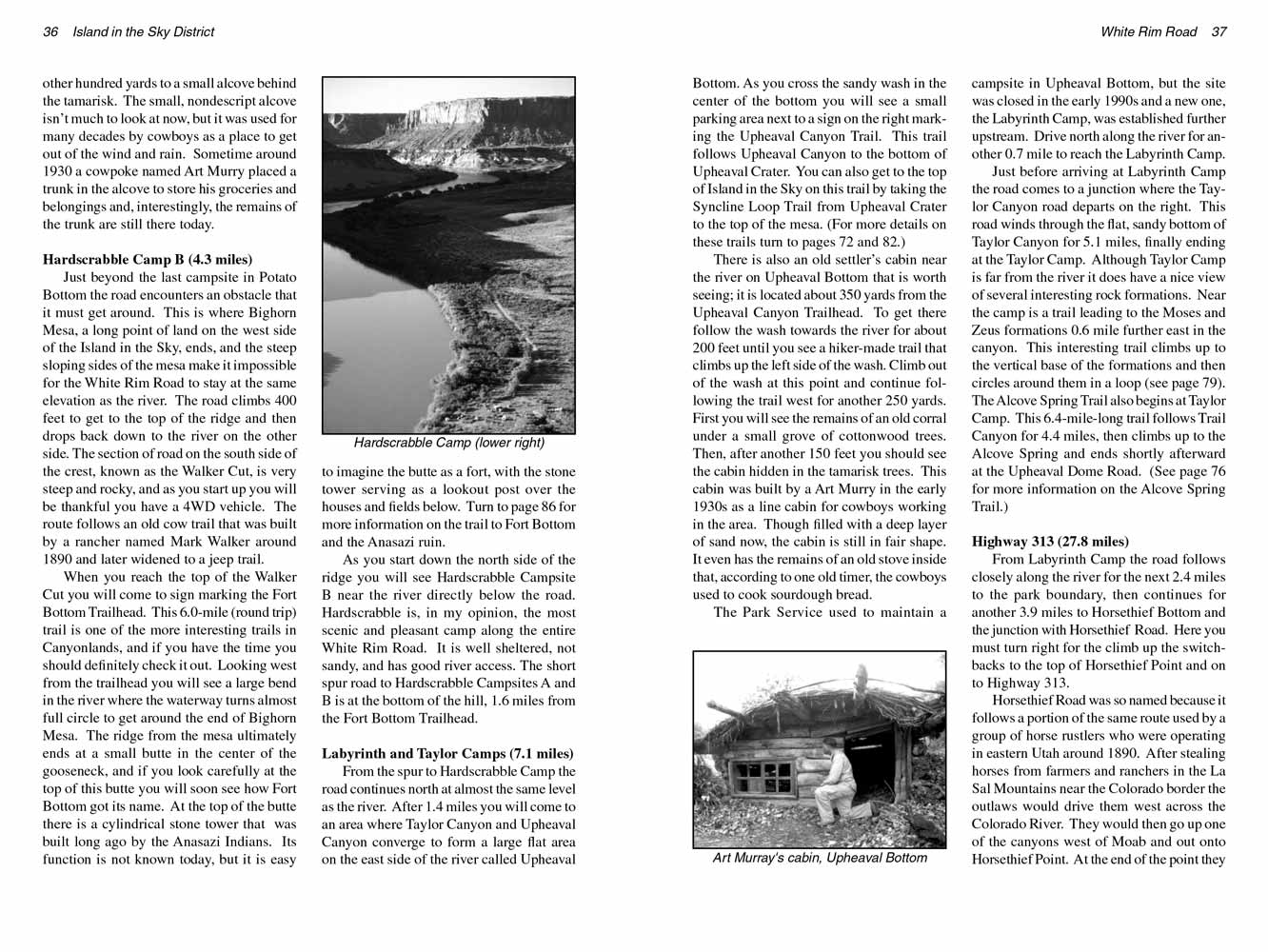 3.3 miles north of Queen Anne Bottom the White Rim Road arrives at Potato Bottom Campsite A and, after another 0.7 mile, campsites B and C.
All three sites are pleasantly located in the cottonwood trees on a bench just above the river. Notice that the White Rim Sandstone disappears beneath
the surface at this point. The remainder of the White Rim Road will be over the shale of the Moenkopi and Chinle Formations.
3.3 miles north of Queen Anne Bottom the White Rim Road arrives at Potato Bottom Campsite A and, after another 0.7 mile, campsites B and C.
All three sites are pleasantly located in the cottonwood trees on a bench just above the river. Notice that the White Rim Sandstone disappears beneath
the surface at this point. The remainder of the White Rim Road will be over the shale of the Moenkopi and Chinle Formations.
There is no evidence that Potato Bottom was ever homesteaded, but it was often used during the first half of the last century as a cowboy camp. One of
the camps is located 0.3 miles south of Potato Bottom Campsite A, near where the White Rim Sandstone disappears underground. Drive back from the
campsite to the last place where you can easily park off the White Rim Road, then walk south along the bottom of the White Rim for another hundred yards to a
small alcove behind the tamarisk. The small, nondescript alcove isn’t much to look at now, but it was used for many decades by cowboys as a place
to get out of the wind and rain. Sometime around 1930 a cowpoke named Art Murry placed a trunk in the alcove to store his groceries and belongings
and, interestingly, the remains of the trunk are still there today.
Hardscrabble Camp B (4.3 miles)
Just beyond the last campsite in Potato Bottom the
White Rim Road encounters an obstacle that it must get around. This is where Bighorn Mesa, a long point of
land on the west side of the Island in the Sky, ends, and the steep sloping sides of the mesa make it impossible for the White Rim Road to stay at
the same elevation as the river. The road climbs 400 feet to get to the top of the ridge and then drops back down to the river on the other side.
The section of ;the White Rim Road on the south side of the crest, known as the Walker Cut, is very steep and rocky, and as you start up you will be thankful you
have a 4WD vehicle. The route follows an old cow trail that was built by a rancher named Mark Walker around 1890 and later widened to a jeep trail.
When you reach the top of the Walker Cut you will come to sign marking the Fort Bottom Trailhead. This 6.0-mile (round trip) trail is one of the more
interesting trails in Canyonlands, and if you have the time you should definitely check it out. Looking west from the trailhead you will see a large
bend in the river where the waterway turns almost full circle to get around the end of Bighorn Mesa. The ridge from the mesa ultimately ends at a
small butte in the center of the gooseneck, and if you look carefully at the top of this butte you will soon see how Fort Bottom got its name. At
the top of the butte there is a cylindrical stone tower that was built long ago by the Anasazi Indians. Its function is not known today, but it
is easy to imagine the butte as a fort, with the stone tower serving as a lookout post over the houses and fields below. Turn to page 86 for more
information on the trail to Fort Bottom and the Anasazi ruin.
As you start down the north side of the ridge you will see Hardscrabble Campsite B near the river directly below the road. Hardscrabble is, in my
opinion, the most scenic and pleasant camp along the entire White Rim Road. It is well sheltered, not sandy, and has good river access. The short
spur road to Hardscrabble Campsites A and B is at the bottom of the hill, 1.6 miles from the Fort Bottom Trailhead.
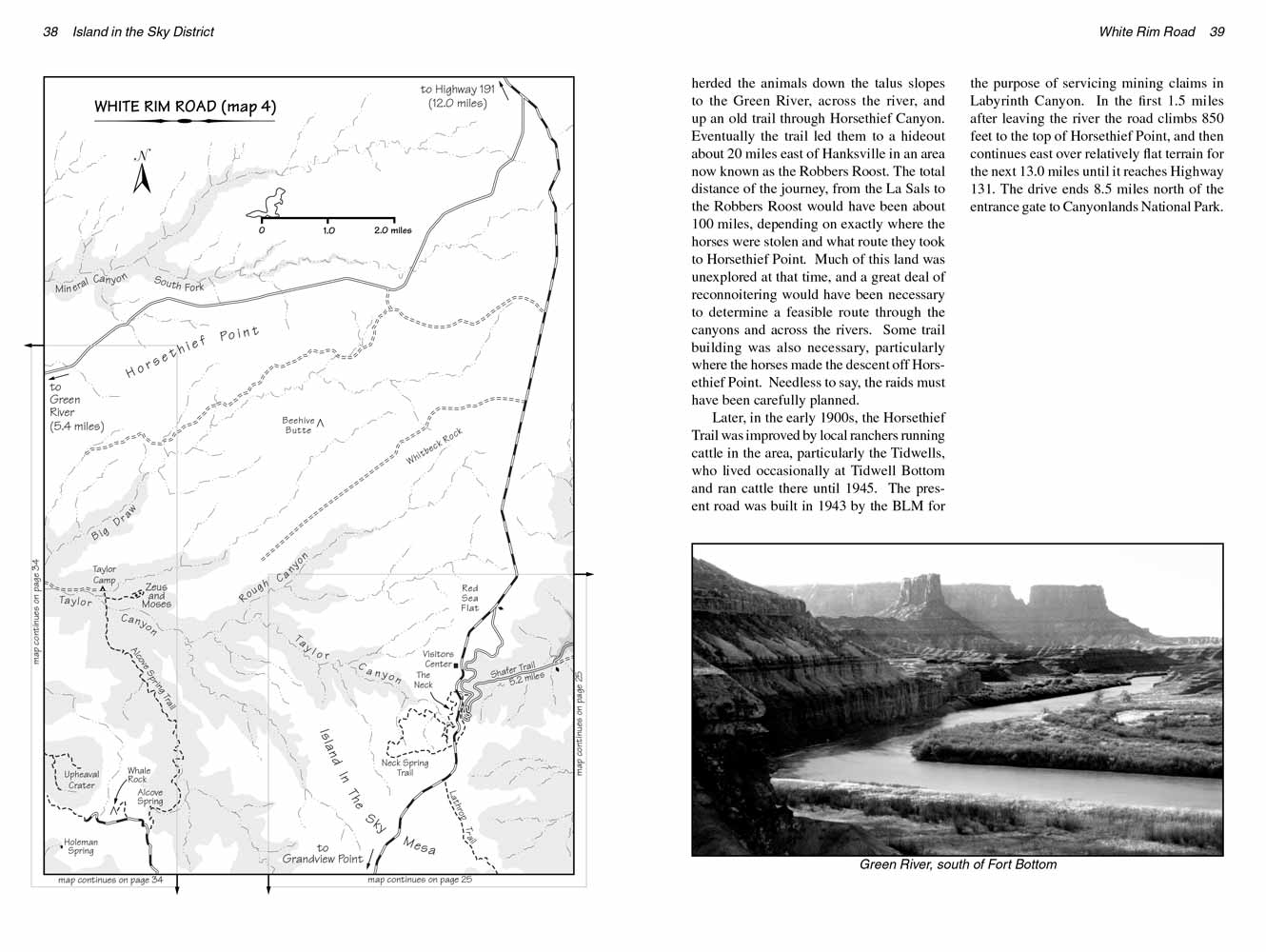 Labyrinth and Taylor Camps (7.1 miles)
Labyrinth and Taylor Camps (7.1 miles)
From the spur to Hardscrabble Camp the White Rim Road continues north at almost the same level as the river. After 1.4 miles you will come to an area where Taylor
Canyon and Upheaval Canyon converge to form a large flat area on the east side of the river called Upheaval Bottom. As you cross the sandy wash in the
center of the bottom you will see a small parking area next to a sign on the right marking the Upheaval Canyon Trail. This trail follows Upheaval
Canyon to the bottom of Upheaval Crater. You can also get to the top of Island in the Sky on this trail by taking the Syncline Loop Trail from
Upheaval Crater to the top of the mesa. (For more details on these trails turn to pages 72 and 82.)
There is also an old settler’s cabin near the river on Upheaval Bottom that is worth seeing; it is located about 350 yards from the Upheaval Canyon
Trailhead. To get there follow the wash towards the river for about 200 feet until you see a hiker-made trail that climbs up the left side of the
wash. Climb out of the wash at this point and continue following the trail west for another 250 yards. First you will see the remains of an old
corral under a small grove of cottonwood trees. Then, after another 150 feet you should see the cabin hidden in the tamarisk trees. This cabin
was built by a Art Murry in the early 1930s as a line cabin for cowboys working in the area. Though filled with a deep layer of sand now, the
cabin is still in fair shape. It even has the remains of an old stove inside that, according to one old timer, the cowboys used to cook sourdough
bread.
The Park Service used to maintain a campsite in Upheaval Bottom, but the site was closed in the early 1990s and a new one, the Labyrinth Camp, was
established further upstream. Drive north along the river for another 0.7 mile to reach the Labyrinth Camp.
Just before arriving at Labyrinth Camp the
White Rim Road comes to a junction where the Taylor Canyon road departs on the right. This road winds through the flat,
sandy bottom of Taylor Canyon for 5.1 miles, finally ending at the Taylor Camp. Although Taylor Camp is far from the river it does have a nice view of
several interesting rock formations. Near the camp is a trail leading to the Moses and Zeus formations 0.6 mile further east in the canyon. This
interesting trail climbs up to the vertical base of the formations and then circles around them in a loop (see page 79). The Alcove Spring Trail
also begins at Taylor Camp. This 6.4-mile-long trail follows Trail Canyon for 4.4 miles, then climbs up to the Alcove Spring and ends shortly
afterward at the Upheaval Dome Road. (See page 76 for more information on the Alcove Spring Trail.)
Highway 313 (27.8 miles)
From Labyrinth Camp the White Rim Road follows closely along the river for the next 2.4 miles to the park boundary, then continues for another 3.9 miles to Horsethief Bottom and the junction with Horsethief Road. Here you must turn right for the climb up the switchbacks to the top of Horsethief Point
and on to Highway 313.
Horsethief Road was so named because it follows a portion of the same route used by a group of horse rustlers who were operating in eastern Utah
around 1890. After stealing horses from farmers and ranchers in the La Sal Mountains near the Colorado border the outlaws would drive them west
across the Colorado River. They would then go up one of the canyons west of Moab and out onto Horsethief Point. At the end of the point they herded
the animals down the talus slopes to the Green River, across the river, and up an old trail through Horsethief Canyon. Eventually the trail led
them to a hideout about 20 miles east of Hanksville in an area now known as the Robbers Roost. The total distance of the journey, from the La Sals
to the Robbers Roost would have been about 100 miles, depending on exactly where the horses were stolen and what route they took to Horsethief Point.
Much of this land was unexplored at that time, and a great deal of reconnoitering would have been necessary to determine a feasible route through
the canyons and across the rivers. Some trail building was also necessary, particularly where the horses made the descent off Horsethief Point.
Needless to say, the raids must have been carefully planned.
Later, in the early 1900s, the Horsethief Trail was improved by local ranchers running cattle in the area, particularly the Tidwells, who lived
occasionally at Tidwell Bottom and ran cattle there until 1945. The present road was built in 1943 by the BLM for the purpose of servicing mining
claims in Labyrinth Canyon. In the first 1.5 miles after leaving the river the road climbs 850 feet to the top of Horsethief Point, and then
continues east over relatively flat terrain for the next 13.0 miles until it reaches Highway 131. The drive ends 8.5 miles north of the entrance
gate to Canyonlands National Park.
Note to web developers: You may copy this material onto your site, but in return please include a link to my home page
www.utahtrails.com. Thank you, David Day (utahdavidday at gmail.com)
Click here to see more trails in
Canyonlands National Park
© Rincon Publishing Company, all rights reserved
|



 Before driving the White Rim Road you should be sure to spend some time at the overlook points on the Island in the Sky Mesa south of the
visitor center. The thread of the White Rim Road can clearly be seen from all of these vantage points, as it winds its way across the White Rim Plateau
1,200 feet below the mesa. The views are extremely impressive, and few observers will not feel a pang of excitement at the prospect of following the
road through the canyon below. The views are particularly striking from the Grandview and White Rim Overlooks at the south end of the Grandview Point,
where the White Rim Road skirts around Monument Basin and Gooseberry Canyon above the western side of the Colorado River.
Before driving the White Rim Road you should be sure to spend some time at the overlook points on the Island in the Sky Mesa south of the
visitor center. The thread of the White Rim Road can clearly be seen from all of these vantage points, as it winds its way across the White Rim Plateau
1,200 feet below the mesa. The views are extremely impressive, and few observers will not feel a pang of excitement at the prospect of following the
road through the canyon below. The views are particularly striking from the Grandview and White Rim Overlooks at the south end of the Grandview Point,
where the White Rim Road skirts around Monument Basin and Gooseberry Canyon above the western side of the Colorado River.
 The White Rim Road continues along the top of the White Rim Formation as it proceeds south from the Gooseneck Trailhead. Initially the
sandstone layer is less than ten feet thick, but it gradually becomes much thicker. After another 1.8 miles you will come to another sign that says
“Colorado River Overlook”, and from there a short spur road leads to another overlook point just 300 yards from the main road. This view of the river
is not as spectacular as the one from the end of the Gooseneck Trail, but no hiking is required to reach the Colorado River Overlook.
The White Rim Road continues along the top of the White Rim Formation as it proceeds south from the Gooseneck Trailhead. Initially the
sandstone layer is less than ten feet thick, but it gradually becomes much thicker. After another 1.8 miles you will come to another sign that says
“Colorado River Overlook”, and from there a short spur road leads to another overlook point just 300 yards from the main road. This view of the river
is not as spectacular as the one from the end of the Gooseneck Trail, but no hiking is required to reach the Colorado River Overlook.
 For the next 7.5 miles after leaving Musselman Arch the White Rim Road continues southward over the flat sandy plateau, passing near
the rim of Musselman Canyon, Little Bridge Canyon, and finally Lathrop Canyon. The Colorado River is no longer visible; nevertheless there are a number
of impressive vistas along the way. On your right are the rouge-colored cliffs of the Wingate Formation plunging down from the top of the Island in
the Sky, and on your left are the rugged canyons below the White Rim, deeply cut into the dark red shale of the Cutler Formation. The White Rim Road
is usually good enough for almost any car to travel as far as Musselman Arch, but ordinary cars will run into trouble a few miles beyond the arch.
Pickup trucks and other high-center vehicles can usually make it another 34 miles to the bottom of the Murphy Hogback.
For the next 7.5 miles after leaving Musselman Arch the White Rim Road continues southward over the flat sandy plateau, passing near
the rim of Musselman Canyon, Little Bridge Canyon, and finally Lathrop Canyon. The Colorado River is no longer visible; nevertheless there are a number
of impressive vistas along the way. On your right are the rouge-colored cliffs of the Wingate Formation plunging down from the top of the Island in
the Sky, and on your left are the rugged canyons below the White Rim, deeply cut into the dark red shale of the Cutler Formation. The White Rim Road
is usually good enough for almost any car to travel as far as Musselman Arch, but ordinary cars will run into trouble a few miles beyond the arch.
Pickup trucks and other high-center vehicles can usually make it another 34 miles to the bottom of the Murphy Hogback.
 Gooseberry Camp (10.6 miles)
Gooseberry Camp (10.6 miles)
 Murphy Camp (8.8 miles)
Murphy Camp (8.8 miles)
 The bottom land below the Turks Head once supported a thriving community of Anasazi Indians, and the remnants of their occupancy are
scattered throughout the area. If you study the cliffs above the lower terrace on the northeast side of the butte with a pair of binoculars you should
be able to see at least three well preserved cliff dwellings where the ancient Indians lived and stored their corn. The area was extensively
cultivated, and the presence of thousands of flint chips scattered about the ground shows that the Indians who lived here were also actively engaged
in the production of spearheads or other stone tools.
The bottom land below the Turks Head once supported a thriving community of Anasazi Indians, and the remnants of their occupancy are
scattered throughout the area. If you study the cliffs above the lower terrace on the northeast side of the butte with a pair of binoculars you should
be able to see at least three well preserved cliff dwellings where the ancient Indians lived and stored their corn. The area was extensively
cultivated, and the presence of thousands of flint chips scattered about the ground shows that the Indians who lived here were also actively engaged
in the production of spearheads or other stone tools.
 Potato Bottom Camp (10.2 miles)
Potato Bottom Camp (10.2 miles)
 3.3 miles north of Queen Anne Bottom the White Rim Road arrives at Potato Bottom Campsite A and, after another 0.7 mile, campsites B and C.
All three sites are pleasantly located in the cottonwood trees on a bench just above the river. Notice that the White Rim Sandstone disappears beneath
the surface at this point. The remainder of the White Rim Road will be over the shale of the Moenkopi and Chinle Formations.
3.3 miles north of Queen Anne Bottom the White Rim Road arrives at Potato Bottom Campsite A and, after another 0.7 mile, campsites B and C.
All three sites are pleasantly located in the cottonwood trees on a bench just above the river. Notice that the White Rim Sandstone disappears beneath
the surface at this point. The remainder of the White Rim Road will be over the shale of the Moenkopi and Chinle Formations.
 Labyrinth and Taylor Camps (7.1 miles)
Labyrinth and Taylor Camps (7.1 miles)